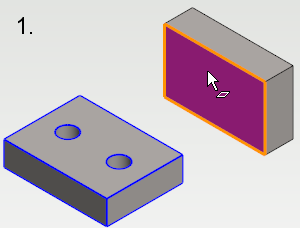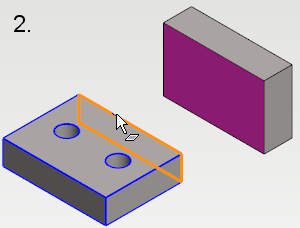Add a Constraint
The constraint can be added in three different ways. Select one of the following:
- Add a constraint between two elements (face, line or point) without selecting the part first.
- Select | Constraints | eg. .
- Select the first element.
- Select the second element:
There is no need to select the part before selecting the element.


Figure 1: Example: After selecting the constraint, select the first element (1), and then the second element (2). - If you want to select an element that is on the other side of the part or otherwise hidden, select the parts first while pressing Ctrl key.
- Select both parts while holding down the Ctrl key.
- Select | Constraints | eg. .
- Select the first part's element.
- Select the second part's element.
Note:- When adding an assembly constraint like this, the program makes the basic planes of the selected instances visible, and they are selectable if reference geometry is visible. If one or more basic planes of a selected instance are already visible, the hidden basic planes are not made visible.
- Instead of handles, the basic planes are shown when adding assembly constraints like this. Reference geometry must be visible in order for the basic planes to be shown.
- Planes are scaled automatically based on the size of the model. If a plane is visible, it is not scaled when adding constraints. If a plane is too small or too big despite scaling, see the next bullet point.
- If you want to select an element, that is on the other side of the part or otherwise hidden, use the function Select an Element through a Face.
Note:
- Change a constraint to another from the context-sensitive menu.
- When adding constraints, the software illutrates unconstrained parts by changing the normally black edge line to blue edge line. Change the visibility of the edge lines in the graphics settings.

 Add distance constraint
Add distance constraint